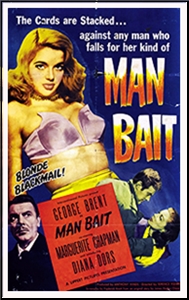August 2018
Monthly Archive
Sun 12 Aug 2018
Posted by Steve under
Reviews[4] Comments
REVIEWED BY BARRY GARDNER:
ELLIS PETERS – Brother Cadfael’s Penance. Brother Cadfael #20. Mysterious Press, hardcover, 1994; paperback, 1996.

Does this series need any introduction? If not the first, it’s certainly the best known of the the histo-mysteries, and its fans are legion.
King Stephen and Queen Maud (as each would have it for themselves but not the other) are still quarreling bloodily over who is to rule England in 1146 AD. As a byproduct of one of the frequent pieces of treachery involved in the conflict, a young man in Maud’s service is handed over to the enemy, and no one seems to know who has him, or to what end.
Longtime readers of the series will recognize him immediately; others will have to wait for the text to explain why Brother Cadfael feels compelled to go in search for him, along with his friend Sheriff Hugh Berenger. The first step is to attend a gathering at Coventry to bring the two factions to peace, but peace isn’t what Brother Cadfael finds there.
Given my predilection for historical mysteries, British fiction, and the Middle Ages, it’s no surprise that I liked this a great deal. Cadfael is an enduring and endearing character, and Peters writes a brand of cadenced prose that goes down very easily. The historical background is authentic and worked seamlessly into the text; indeed is an integral part of it.
I don’t find anything to dislike in the Cadfael books. As with any series there are similarities from book to book, but somehow Peters to mu eye has avoided any hint of staleness in the 20 books so far. Fine stuff.
— Reprinted from Ah Sweet Mysteries #16, November 1994.
Sat 11 Aug 2018
REVIEWED BY JONATHAN LEWIS:
REPORT TO THE COMMISSIONER. United Artists, 1975. Michael Moriarty, Yaphet Kotto, Susan Blakely, Hector Elizondo, Tony King. Screenplay by Abby Mann and Ernest Tidyman, based on the novel by James Mills. Director: Milton Katselas.

For fans of gritty 1970s urban cinema, Report to the Commissioner has a lot to offer. Filmed on location in and around Times Square, this police procedural also features a lot of the great character actors from that era: Yaphet Kotto, William Devane, Vic Tayback, Bob Balaban, as well as a young Richard Gere as a pimp.
But the star of the film is a youngish, occasionally overacting Michael Moriarty who portrays a green NYC cop who is way too much of an idealist for an increasingly embittered and cynical police force. His character, Bo Lockley, is the son of a NYPD cop who always wanted his son to join the force. The other son that is, the one who got killed in Vietnam. So Bo joins the force in place of his dead brother. Problem is: Bo is at heart a lefty and a hippie who simply doesn’t belong as a boy in blue. His partner, Crunch Blackstone (Kotto) knows this from the get go and does his absolute best to make sure that Bo doesn’t get himself in trouble with his superiors.

It’s too little too late. For we get the sense that Bo was doomed from the start, from the moment he walked into the precinct. The movie, which unfolds in flashbacks, begins with Blackstone finding the body of a dead junkie in the apartment of a known heroin pusher named Stick Henderson (Tony King). His main suspect: Bo.
Report to the Commissioner proceeds to tell the story of how Bo was set up by his superiors to go on a wild goose chase in the search for a runaway named Chicklet. What he isn’t told is that Chicklet is really an undercover cop named Patty Butler (Susan Blakely) who has gone deep undercover on an unauthorized mission to bring down Stick, the heroin dealer who also doubles as a black militant. Note: Abby Mann was one of the screenwriters, so there’s a great deal of social justice messaging afoot here.

Although Moriarity puts in a good performance, it’s really the city that’s the star here. You can just feel the oppressive, sensory overwhelming nature of Times Square circa 1972. It’s a land of sleazy movie theaters, overwhelming crowds, and strange characters.
Report to the Commissioner isn’t a great film, but it’s better than average and from what I can tell, has largely been forgotten. I watched it on a Kino Lorber Blu Ray. It looks great and if the story appeals to you, this version is definitely worth seeking out.
—
Fri 10 Aug 2018
REVIEWED BY WALTER ALBERT:

BROADWAY BILL. Columbia Pictures, 1934. Warner Baxter, Myrna Loy, Walter Connolly, Helen Vinson, Douglass Dumbrille, Raymond Walburn, Lynne Overman, Clarence Muse, Margaret Hamilton, Frankie Darro. Director: Frank Capra. Shown at Cinevent 22, Columbus OH, May 1990.
What a wonderful cast. A racetrack comedy/drama, not a genre I am particularly fond of, but easy to take here. The climax astonished us and broke our hearts. Even the upbeat ending didn’t do much to improve the mood of the audience that quietly filed out.
[PLOT WARNING.] I don’t want to tease you, so I am going to reveal the climax. The film is about a race horse that is trained by Baxter to win the big race against all odds. The horse, running valiantly wins, and then drops dead; its generous heart, weakened by an earlier bout with a virus, burst.
Thu 9 Aug 2018
REVIEWED BY DAN STUMPF:
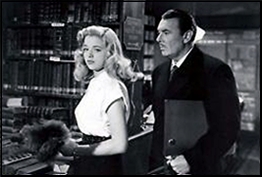
MAN BAIT. Hammer Films-UK / Lippert Pictures-US, 1952. George Brent, Marguerite Chapman, Diana Dors, Raymond Huntley. Peter Reynolds, and Meredith Edwards. Screenplay by Frederick Knott, based on The Last Page, a play by James Hadley Chase. Directed by Terence Fisher.
A Pleasant surprise with the unlikely title Man Bait showed up on the bottom half of a double bill DVD billed as “Hammer Noir,†one of a series of co-productions between Hammer Studios and producer Robert Lippert.
BORING BACKGROUND – SKIP THIS PART: Robert Lippert was a producer of legendary cheapness and dubious ethics who churned out a slew of low-budget movies in the 1950s & 60s, mostly aimed at rural audiences and double bills. His favorite actors were Sid Melton, who didn’t need a script, and Margia Dean, whom he was sleeping with. When he hired bigger “name†actors (heavyweights like Cesar Romero or Rod Cameron) it was usually on a profit-sharing deal where the profits never materialized. As far as I can tell, the only ones who ever got a fair shake from Lippert were Sam Fuller, who carried a gun, and George Raft, who had Mob connections.
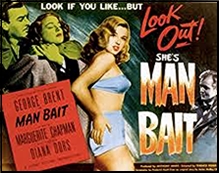
In the early 50s, Lippert discovered that the British government was subsidizing film production in England, and he could actually make movies cheaper there in partnership with a British studio. He hit upon the ploy of casting fading second-rank Hollywood “stars†(Raft, Romero, Scott Brady, Zachary Scott, and the like) for dubious box office power in the states, and a whole new sub-genre was born: the Anglo-American B-movie, which flourished, after a fashion, until the moguls at Hammer got a grasp on Lippert’s slippery bookkeeping.
AND NOW BACK TO THE MOVIE: This one stars audience-magnet George Brent and a very capable cast of Brits, including Raymond Huntley, playing his usual nasty martinet, Diana Dors as a sensuous not-quite-innocent, and Peter Reynolds, perfectly slimy as the small-time spiv who tempts our Diana into blackmail and murder — in a bookstore.

The plot has some surprising twists in it, but the strength of Man Bait is in the characterizations and atmosphere. Director Terence Fisher perfectly evokes the feel of a little book shop — all nooks and crannies and crowded shelves — and the writers people it with real bookstore-types if you know what I mean.
Which leads me to speculate on where they came from. I have read some of James Hadley Chase’s novels, and I’ll be charitable by saying characterization is not his strong suit. Man Bait is based on a stage play apparently by Chase, The Last Page. I can find no more about it, but the presence of Frederick Knott, just before he hit it big with Dial M for Murder leads me to suspect he played a strong hand in fashioning this film, and perhaps the play as well.
Whatever the case, Man Bait zips along suspensefully, with Brent framed for murder and the police oh-so-slowly figuring things out as another killing looms just ahead. Terence Fisher makes an impressive directorial debut, and even George Brent, never terribly exciting, lends a surprising inner strength to his quiet role. This one’s a winner.
Wed 8 Aug 2018
Posted by Steve under
Reviews[7] Comments
KIERAN ABBEY – Beyond the Dark. Dell #93, mapback edition, no date stated [1945]. First published by Charles Scribner’s Sons, hardcover, 1944.

This one begins at Inspiration Point, overlooking the Hudson River at the uppermost tip of the island of Manhattan. A man and a woman, strangers to each other, are watching the boats on the water below. He offers her a cigarette. She accepts. Three men come walking up from the parkway below, deep in conversation. When they see the pair of them at the top, they stop talking and pull out their guns. Shots ring out.
The couple, still strangers, flee together, making their way downtown by means of a police car they steal, having found it left unmanned nearby. Thus begins one of the most Woolrichian tale of constant capture. escape and chase — up and down and across the entire city — that I’ve had the pleasure of reading in a good long while. Not only are the police after them, but the FBI, and of course the gang of conspirators the men who shot at them are a part of.
Both of them has a reason, not revealed, for not wanting to go to the police. Neither has anyone in the entire city they can turn to for help. Worse, when they return to the apartment the girl has borrowed for the duration of her stay, they find the body of one of then men who shot at them, recently and definitely deceased.
If you could stop reading at this point, you’re a better person than I. Of course the explanation of how these two people got into a fix like this is not nearly as interesting as the story of how they find their way out of it. No matter. This one was a pleasure to read.
Kieran Abbey was a pseudonym for Helen Reilly, who was, as you may already know, the author of several dozen Inspector McKee police procedural novels. This is the third of only three she wrote under this name, all during the 40s. It’s a book filled with the sights and sounds of late wartime New York City, showing another side of the author I wasn’t aware of before.
Tue 7 Aug 2018

SPY TRAIN. Monogram, 1943. Richard Travis, Catherine Craig, Chick Chandler, Thelma White, Evelyn Brent. Director: Harold Young.
An overall (and honest) assessment of this dopey low-budget anti-Nazi film from the 1940s is that it’s just another dopey low-budget anti-Nazi film from the 1940s. And yet, once past the opening premise — that thanks to a boneheaded error by one of the bad guys — there’s a bomb in a suitcase on a train and it’s set to go off at 10 PM or if anyone tries to open it — it’s actually a lot of fun to watch.

The setting — mostly confined to two or three cars on a speeding train — and the name recognition of the various players — are modest. Richard Travis plays an author who’s trying to visit his rclsive newspaper publisher to find out why his articles on Nazis hard at work in this country have such an become suppressed. Luckily the man’s daughter (Catherine Craig) is on board the train, and he does his best to cozy up to her.
And here are a couple of lines that I thought funny that I hadn’t heard before. She discovers who he is from seeing his photo on the back cover of his latest book:

Jane: “Pretty good book — who wrote it for you?”
Bruce: “I’m glad you liked it — who read it to you?”
Bruce’s companion. a photographer played by Chick Chandler, also has some funny lines as he constantly complains about being stuck with Jane’s maid (Thelma White).
In the end the Nazis get their just desserts. That plus a speeding train. What more could you want?
Tue 7 Aug 2018
FRANK PARRISH – Snare in the Dark. Constable, UK, hardcover, 1982. Dodd Mead, US, hardcover, 1981. Perennial, US, paperback, 1983.

Dan Mallett is a poacher by profession — he once was a banker and didn’t like it — so he went back to the way of his father — to his now aged mother’s dismay.
Caught in the open while setting up snares for a forest filled with plump pheasants, a shot rings out (in all honesty, not quite — it’s an arrow from a crossbow) and his gamekeeper nemesis is dead. Mallett has to spend the rest of the book with the police on his trail. The only way to clear himself is to find the real killer.
It doesn’t seem like a lot to base a full length novel on, but Parrish somehow finds a way to fill the pages and keep them turning at the same time. What’s amusing about this case is how women are attracted to Mallett, a short and not very handsome man. But obviously not one without some charm, and in its own quiet bucolic way, so is this, his third of eight adventures. If you like books about the rustic side of English life as it was in the 1970s and 80s, don’t miss this one.
The Dan Mallett series —
Fire in the Barley. Constable, 1977.
Sting of the Honeybee. Constable, 1978.
Snare in the Dark. Constable, 1982.
Bait on the Hook. Constable, 1983.
Face at the Window. Constable, 1984.
Fly in the Cobweb. Constable, 1986.
Caught in the Birdlime. Constable, 1987.
Voices from the Dark. Constable, 1993.
Mon 6 Aug 2018
Posted by Steve under
Reviews1 Comment
MARGARET YORKE – Dead in the Morning. Dr. Patrick Grant #1. Bantam, paperback; 1st US printing, October 1982. First published in the UK by Geoffrey Bles, hardcover, 1970.

I read and reviewed Cast for Death, the fifth and last of Margaret Yorke’s Patrick Grant books, earlier this year and found it somewhat of a muddle as a detective novel, but I did find Dr. Grant’s struggle with love and romance quite enjoyable.
Dead in the Morning, the first of the series, is a total opposite: no romance in sight for Dr. Grant, and the detective story is both engaging and fun to read. He is not a medical doctor, by the way, but an Oxford don with a (very) inquisitive mind.
As a twist to what we come to expect in stories like one — an aged, invalid matriarch of a dysfunctional family who also keeps a close tight watch on her pursestrings — it is not she who is the murder victim, but surprisingly enough, it is the cook instead. Could she have known more about someone in the family than she should have? Someone who did not want that something known?
I liked this one, and it only goes to show that when you read the books in a series out of order — or in this case, last one first — you ought not to give up on the earlier ones as well.
NOTE: A previous review by me was posted here last year, but my comments themselves were written in 1980.
Mon 6 Aug 2018
Posted by Steve under
Reviews[6] Comments
REVIEWED BY DAVID VINEYARD:
MAURICE LEBLANC – Countess Cagliosto. Arsène Lupin #12. First published in France as La Comtesse de Cagliostro (1924). First translated into English in 2010 and included in Arsene Lupin vs Countess Cagliostro, edited by Jean-Marc & Randy Lofficier (Black Coast Press, trade paperback). Also included in this latter edition are the 1935 novel Countess Cagliostro’s Revenge, also never before translated. The book also includes the short story “The Queen’s Necklace,” and the all-new The Death of Countess Cagliostro, written by Jean-Marc & Randy Lofficier. Film: Arsène Lupin (2004).

Maurice Leblanc, a forty-one year old journalist, created the French rival to Sherlock Holmes in 1905 in the short “l’aresstation de Arsene Lupinâ€. It was a bright and clever tale (foreshadowing Agatha Christie’s Roger Ackroyd) introducing the world to the gentleman thief and romantic adventurer whose lust for life was almost as great as his lust for other people’s things.
Not unnaturally over time Lupin evolved, showing as great a skill at solving crime as committing it, taking on Sherlock Holmes (Holmlock Shears) in two adventures, and appearing in classics of the genre like 813 and The Hollow Needle.
And like Sherlock Holmes, Lupin’s creator grew tired of his hero, and with the end of the Great War increasingly sidelined Lupin under various guises, in short appearances, and as a deus ex machina when a complex plot needed one. Individual stories were worthwhile, but nothing as great as his heyday. Readers must have wondered if Lupin would ever see his great days again
But again as with Sherlock Holmes and The Hound of the Baskervilles, Leblanc had one last trick up his sleeve — one last great adventure to recount. That adventure would be nothing less that the origin of Arsene Lupin, and of his greatest foe and implacable enemy, Josephine Balsamo, the possibly immortal daughter of Joseph Balsamo, Count Cagliostro, in the 1924 novel that bore her name.
Lupin fans must have celebrated, Leblanc and his hero were back in fine form.
After a brief forward explaining Lupin had forbid him to tell the story of the Countess for twenty-five years, Leblanc plunges right in as young Raoul d’Andrésy breaks into the home of the Baron d’Etigues, father of Clarisse, the young woman he loves, and finds among his papers an order to execute a mysterious unnamed woman.
Being French, he of course wakes and seduces Clarisse and then reveals to her that her father and his cronies “…Marquis de Rolleville, Mathieu de la Vaupalière, Comte Oscar de Bennetot, Roux d’Estiers… All these noblemen from the beautiful Pays de Caux are involved in some kind of fantastic conspiracy!†D’Andrésy soon reveals he is really Arsene Lupin, the son of a footman and fencing and boxing instructor, something that her father would never accept as a son-in-law. But as he assures her with typical bravado, he has a bright future:
“Every fortune-teller I’ve ever met has predicted I will have a great future and worldwide fame. Raoul d’Andrésy will become a General, a Minister, or an Ambassador… unless it’s Arsène Lupin! It’s a pact I’ve made with Destiny, agreed and signed by both parties. I’m ready! I’ve got muscles of steel and a sharp mind. Would you like to see me walk on my hands, or lift you at arms’ length? Or would you prefer that I remove your watch without you noticing? Or shall I recite Homer in Greek or Milton in English from memory? My God, how sweet life is! Raoul d’Andrésy… Arsène Lupin… A monument with two faces—which one will be illuminated by Glory, the brightest star in all the Heavens?â€
Fate has a different kind of fame in store for him though.
Intercepting the would-be executioners, Lupin is present when they bring in their victim and reveal her face:
… a voice rose above the murmurs of surprise. It was that of Prince d’Arcole, who had stepped forward to look at the prisoner.
“It’s her! It’s her!†he stammered, his eyes wide in horror, his face twitching.
“I recognize her! It’s terrifying!â€
“What’s terrifying?†asked the Baron. “Please, explain yourself.†And the Prince uttered this incredible statement:
“She is no older than she was 24 years ago!â€
Of course Lupin will save her, become her lover and student, be drawn into and obsessed with the conspiracy surrounding the treasures of the Kings of France she and the conspirators all covet, he will learn her incredible claim to be the immortal daughter of the infamous Joseph Balsamo. Count Cagliostro.
Lupin doesn’t buy that for a moment:
“You’re your mother’s daughter,†repeated Raoul, “which means that there was a first Countess Cagliostro. At 25 or 30, she dazzled all of Paris in the last days of the Second Empire and piqued the curiosity of the Court of Emperor Napoleon III. With the help of her alleged brother—who may actually have been her lover — she laid out the tale of her connection to Cagliostro and Joséphine de Beauharnais and manufactured the forged documents which the Emperor’s secret police found later when they checked her background. Expelled from France, she fled to Italy, then Germany, then vanished without a trace… Except that she returned 24 years later in the person of an adorable daughter with virtually identical features, the second Countess Cagliostro, hereby present. Do we agree so far?â€
Lupin goes one for several paragraphs before recognizing he has overplayed his hand:
“I’m right, aren’t I?†he said.
“My past is my business,†she said, not answering him, “and so is my age. You can believe whatever you like about them.â€
He took her in his arms and kissed her passionately.
“Then I will choose to believe that you’re 104-years-old, Joséphine, and that there is nothing more delicious.”
Lupin will eventually become her rival (“…what is impossible is that I could continue to see you under that fog of mystery in which you’ve deliberately wrapped yourself; for now, I see you for what you truly are: a murderess and a criminal.â€), learn secrets of his own family, marry Clarisse (like James Bond, Lupin’s lovers don’t last long) and have his son kidnapped by Josephine to take revenge on him twenty five years later (recounted in Countess Cagliostro’s Revenge published here for the first time in English).
This particular Black Coat Press edition includes a short by editors Jean-Marc and Randy Loffcier recounting the final days of the Countess, and a short story, “The Queen’s Necklace†telling of Lupin’s first crime. It also comes with an informative introduction for anyone not already familiar with Lupin’s exploits.
I grant I am a sucker for any tale in which the hero meets his Moriarty, his true nemesis, and this one lives up to both its hero and its epic theme, full of bravado, style, action, and lively twists as well as a fairly melancholy ending. It’s a good introduction to Lupin for those new to his adventures, and a grand addition to them for fans already familiar with him.
American readers may find it hard to take the very French brio of Lupin at first, but staying with it will reveal some of the cleverest mysteries and adventures of any classic hero done in high style.
Sat 4 Aug 2018
CONVENTION REPORT: PulpFest 2018
by Walker Martin
Dedicated to the memory of Rusty Hevelin.
A TALE OF TWO CITIES by Charles Dickens is one of my favorite novels and starts off with the famous passage, “It was the best of times, it was the worst of times, it was the age of wisdom, it was the age of foolishness”. It continues later, “…it was the spring of hope, it was the winter of despair, we had everything before us, we had nothing before us…” This just about sums up my feeling after Pulpfest 2018.

So what happened? On the drive back home, what made me attack a vending machine which tried to keep my dollar bill? The thing was seven feet tall but somehow I was so energized and angry that I shook the small bag of pretzels loose. What made me walk away from arguing with a bunch of fellow collectors, muttering curses, and angry?
People that have known me for a long time know that the love of my life is Pulpcon/Pulpfest. I’ve been attending them since the first one in 1972. My vacation plans are always scheduled around the convention, I’ve attended them with severe back problems, once against the advice of both my chiropractor and physician. I’ve even gone to the show when my employer said I could not go. Like my good pal Harry Noble, I’d probably attend even knowing I had a terminal illness.
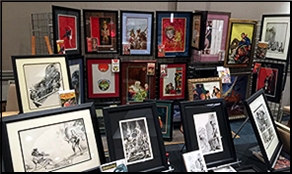
I see Pulpfest as a big event, a big party or picnic. I go to have a good time, not to argue with other collectors and finally walk away grumbling. I had heard rumors of a big announcement which was to be made at the business meeting. It still surprised me to hear the news that Pulpfest might go back to Columbus, Ohio next year and what’s more might be connected in some way with a comic book convention.
The committee mentioned that assistance would be provided by an unnamed comic book dealer and convention organizer. As far as I know only very few collectors questioned this plan. I was one plus one committee member said he agreed with me and a couple other collectors were also doubtful.
But most seemed to accept this news. You may notice I dedicated this report to Rusty Hevelin who was responsible for continuing Pulpcon for over 25 years. With Rusty I knew I could walk into the dealer’s room and not see piles of comic books, it would not be another science fiction convention, it would not be full of new pulp books written mainly by non-collectors and amateur writers. It would not be a nostalgia convention. By god, it would be a convention for pulp and book collectors even if only 100 to 200 showed up. They at least would be serious collectors often bringing boxes of pulps, books, vintage paperbacks, slicks, digest, and original art.

Everybody seemed to be moaning about how the attendance was not growing but was stuck at about 375. Still, this was far more than the old Pulpcon ever achieved in 37 years. There may be a thousand or so pulp collectors in the US. But most of them won’t ever come to Pulpfest because of health problems, financial problems, or they can’t get away from their job or family responsibilities. 400 and something is about the maximum that we can expect, though the Windy City Convention has claimed to break the 500 mark. I really don’t see any big increase in attendance being possible unless we want to import a ton of comic collectors, new pulp people and walk ins that seldom buy anything.
But I’m a pulp collector and I want to talk and deal with other pulp collectors. Many comic book collectors seem to like slabbing the books. I’m completely against this because I want to read the things. I don’t want them in a sealed plastic case. But comics are big money and pulps are not. I don’t see us co-existing at all. True, the committee has some personnel problems. Ed Hulse left a few years ago which I saw as a big blow. Bill Lampkin could not make it this year due to family responsibilities, Chuck Welch will soon be moving to Canada, Jack Cullers and Barry Traylor are my age which means they are getting older, to put it kindly.
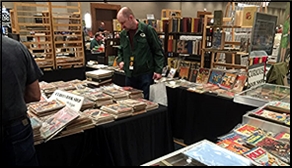
It’s time for me to talk about the convention and stop with my complaints, especially since I seem to have few supporters. Nothing has been decided yet by the committee and we will have to see what happens. I really like the Double Tree Hotel however and hope we return next year.
First, the programming was outstanding as usual. I skipped the new pulp presentations because I don’t care about new pulp. They mainly strike me as non-collectors and as I have said many times, collectors are my favorite type of people. But Thursday the best thing on the program was Sai Shankar talking about the great WW I author, Leonard Nason. I’ve often wondered why people travel to Pulpfest and then miss the programming due to the fact they are stuffing their face.
Well, I’ll be damned if I didn’t miss Sai Shankar, who is one of my friends, talking about one of my favorite ADVENTURE writers, Leonard Nason! His talk was scheduled for 8:40 and we sat down to eat in the hotel restaurant at 7:00 or perhaps even before 7:00. But the service was so slow that we were there forever and as a result we all missed Sai’s talk. Laurie Powers complained to the manager that due to the slow service we missed the program.
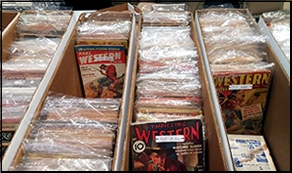
Friday, there were three panels I enjoyed mainly because I have problems with the subjects. I love the art of the men’s adventure magazines and have collected it in the past. I mean what is there not to love about Nazis turning girls into gold ingots? No wonder they lost the war! Bob Deis and Wyatt Doyle talked about the art and the fiction. I often have problems with the fiction but I love the magazines anyway. I know the WW II vets loved them also! They had a table full of their latest books including POLLEN’S WOMEN: The Art of Samson Pollen. I hope they can publish a reference book listing and discussing the many men’s adventure titles. We need such a guide book.
Then I liked the panel on the air war pulps hosted by Don Hutchison. Bill Mann, Chris Kalb and company are doing a great job reprinting many authors of the aviation magazines. I have problem reading these stories but I’m working on it and hope to someday be able to appreciate the fiction. Finally the son of John Fleming Gould talked about his father’s art.
Saturday, started off with the dreaded business meeting which just about ruined my evening but the announcement that Bill Lampkin had been awarded the Munsey Award cheered me up. Bill edits the excellent PULPSTER magazine and is also on the committee. Then the guest of honor, Joe Lansdale, was interviewed. David Saunders gave an excellent talk on the Art of the War Pulps. David discusses art at each Pulpfest and I hope this tradition continues.

For just about the first time the auction was scheduled for two evenings at Pulpfest. Usually the auction is only one night but there was so many lots, over 400 total! Both nights the auction lasted from 10 pm to past 1 am. Some collectors griped that there was nothing at the auction. I disagree. Friday night saw a run of ARGOSY from the thirties, almost 600 issues of WILD WEST WEEKLY from 1927 through 1943, a set of PLANET STORIES, and many miscellaneous lots. The highest priced item by far was the five boxes of Al Tonik’s research papers. It went for $2000.00.
Saturday night saw many lots of WESTERN STORY, many sport titles, and the best conditioned set of SF digests that I have ever seen, and I’ve been collecting for over 60 years. The entire run of these magazines were in astonishing beautiful condition. Nice paper, new looking covers, that great scent of new magazines. I had them all but I was tempted to buy them all just for the beautiful condition. Seeing these lovely magazines reminded me once again about why I am a collector. They are beautiful. Sets of AMAZING, FANTASTIC, GALAXY, ASIMOV’S, ANALOG, F&SF, IF, NEW WORLDS, SCIENCE FANTASY, NEBULA, and IMAGINATION. The IMAGINATION set may be the prettiest thing I’ve seen in a long time. Though I had them all already, I bought the 5 lots making up the over 200 digest issues of AMAZING because the condition was just so much better than my own set.
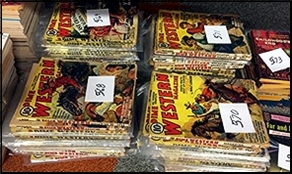
THE PULPSTER, number 27, was the usual excellent issue. 48 large size pages discussing Arthur Sullivant Hoffman’s ADVENTURE, the American Legion in ADVENTURE, artist George Evans and the aviation pulps, Philip Jose Farmer, and a great letter from a college student talking about her the summers she worked for Popular Publications.
I was told that attendance was around the 375 mark which I think was great. The dealer’s room was always buzzing with a lot of activity. The hospitality room was well stocked with craft beer and one night about a dozen pizzas were delivered.
Hopefully soon we will see two new magnificent books about pulp titles we seldom talk about. Laurie Powers book on the romance pulps and the life of Daisy Bacon, the excellent editor of LOVE STORY and DETECTIVE STORY. Michelle Nolan’s book on the sport pulp titles should also be a groundbreaking book on a seldom discussed topic. We desperately need books like these two because I’m tired of the same old hero pulp discussion. I know, I know, everyone loves the hero pulps but after all they were aimed at the teenage boy market and are not really adult fiction. Let’s talk about something new like love and sports!
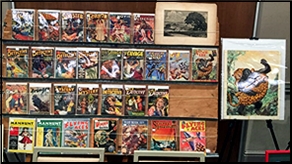
So, you may be wondering what did I buy? Actually this was one of the better Pulpfests for me finding unusual items. As I mention already above, I bought at the auction a lovely set of AMAZING, 1953-1980’s. Simply stunning condition. Here is a listing of what else I found of great interest:
1–Lot of 54 of the 71 isssues of AMRA. AMRA was a SF fanzine published between 1959 and 1982. Edited by George Scithers, it was famous mainly for the articles on Swords and Sorcery. The famous artists and authors that appeared in the magazine are too numerous to name but include Roy Krenkel, Poul Anderson, L. Sprague de Camp, Avram Davidson, Fritz Leiber, Michael Moorcock, and many more. AMRA won the Hugo for best fanzine in 1964 and 1968.
I bought these from Chet Williamson who also sold an interesting Hammett item to someone else and some rare ALL STORY issues. I was a subscriber to AMRA but I sold my issues a long time ago and now I’m rebuilding the set, something I done so many times, with so many magazines.
2–THE AGE OF THE STORYTELLERS: British Popular Fiction Magazines, 1880-1950 by Mike Ashley. This book was published at a hundred dollars but at only $25 I had to get this second copy to add to my first copy. That’s right, the book is so great that you must buy two copies!
3–A framed, signed drawing by the great Edd Cartier. This was only $225 so I had to add it to my Cartier collection which now numbers over 15 drawings. You can never have too many Cartier drawings.
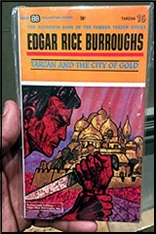
4–A framed painting by pulp collector Lester Belcher showing Sonny Tabor riding on a horse. I knew Lester and he was not an artist but he loved WILD WEST WEEKLY, so he attempted to paint one of the characters from the magazine. I consider it a great piece of “outsider” art done by one of my former friends that I miss. Price at the auction was only $10. Everyone thought it poorly done but to me, knowing Lester, it is priceless.
5–A Richard Powers painting for the Ballantine 1964 paperback, TARZAN AND THE CITY OF GOLD. Done in a different style than usual with Powers. After I bought it the art dealer told me two other collectors stopped by and were disappointed to learn that it had been sold.
6–Two Guest of Honor plaques from Pulpcon. I already have the one given to Walter Baumhofer but I couldn’t pass up these two. One was from 1994 and given to artist R. G. Harris in Tucson. It shows four cover paintings that he did for the pulps. The second is a real treasure since Elmer Kelton was one of the great western writers. It was given to him when he was the guest at the Pulpcon in 1998. It shows four covers from RANCH ROMANCES containing four of his early stories. I hunted for these plaques for decades, now I have three of them!
7–Now the most unusual story of them all. I now have three cover paintings of the paperback western BADLANDS BOSS by Bradford Scott. All by the same artist, Rudy Nappi. It’s possible that there is no other cover painting that was painted three times by the same artist. Back in the early 1980’s I bought the original cover painting at Pulpcon for $100.
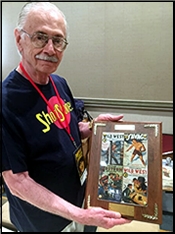
Then several years later I was at Al Tonik’s house for a Tonikcon and there was the same cover by Rudy Nappi also. Al explained that he was not aware the the original cover had survived and so he commissioned Rudy Nappi to paint an exact recreation of the cover. Price he paid was also $100. But the painting was damaged in the mail when the board was bent in order to stick in Al’s mailbox. So he contacted Nappi and told him the sad story and Nappi agreed to paint the painting again for no charge. So now Al had two paintings.
He gave me the damaged one and kept the good one. Actually you can’t see the damage until you look closely and see the board has been bent. Then after Al Tonik’s death what comes up for auction? The third Rudy Nappi cover painting of the same paperback. Since I had two I had to buy the third one also and got it for only $30 at the auction. You can’t make up such an insane story.
So ends my report. Despite my complaints, I truly appreciate the hard work of the committee. Thanks Mike Chomko, Jack Cullers, Sally Cullers, Bill Lampkin, Chuck Welch, and Barry Traylor. Plus the many helpers, and of course thanks to for Sai Shankar for the use of some of the photos he took during the convention. Stay tuned to pulpfest.com for news of next yea’s show.
« Previous Page — Next Page »



